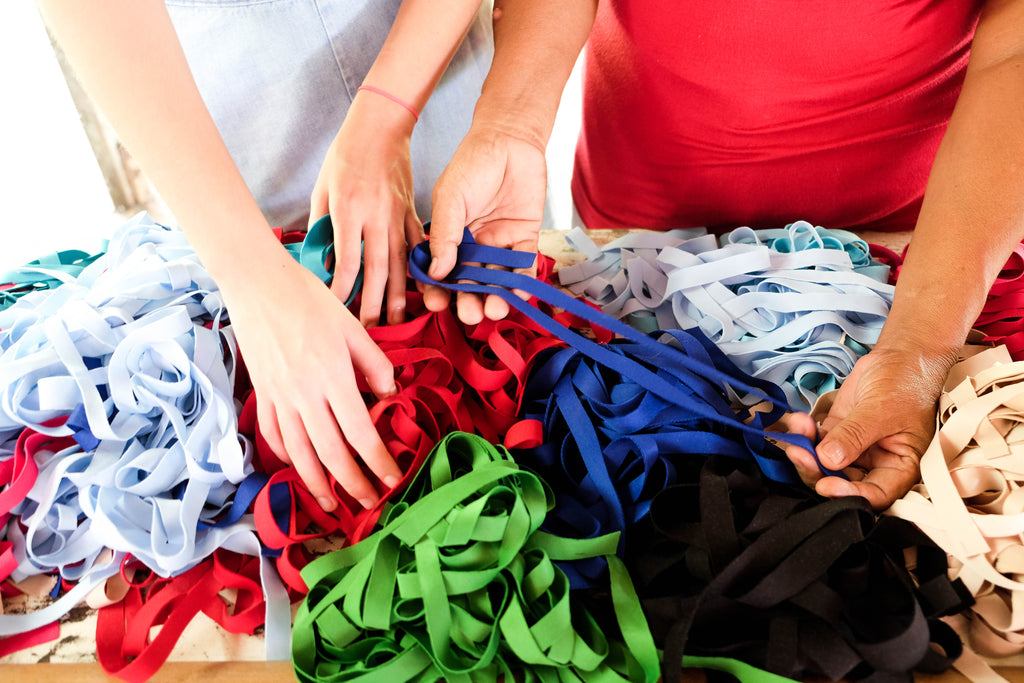By the end of 2016, ANTHILL has literally turned into a growing hill of textile waste from production end cuts and fabric remnants of weaves and non- woven fabrics that have accumulated since our operations in 2010. As our business slowly grew, we also grew a kiloton of seemingly useless pieces of textile waste. Unknowingly, we became part of a big fashion secret: that this luxurious industry is actually the second largest pollutant in the world.
Sustainability is at ANTHILL’s core value. We have always been committed in our mission to elevate culture and support economic empowerment among our partner community artisans. However, beyond cultural, economic and social impact, we knew we also had a role to play in environmental protection. With the belief that sustainability starts with design, we pursued the quest to seek better ways to champion design that cares for the environment while still anchored on growing our cultural footprint through the preservation of our hand loom weaving culture. Our search led us to us to explore the value of upcyling and circular fashion.


Circularity in fashion pertains to restorative and regenerative practices in design and production. It is the giving of new life to materials that are headed to the landfill. It is the extending of the life of materials, giving their lifespan a circular track instead of a linear one. Through our Textile and Apparel Designer Jessica Ouano, we explored the use of textile waste as weft in our weaves through collaborative efforts with our Textile Partner Argao Weaving Community in Cebu, Philippines.
Wefts to Our Warps, Hows to Our Whys
ANTHILL has been working with the Argao Weavers since 2011 as source of our Polyester Abaca weaves. Our engagement with them was limited to providing market access and support in color combinations. Exploring new weaving techniques and the use of waste was a foreign idea for the four founding weavers. They were initially resistant to try because it was difficult and took more time.
The youngest weaver, 22-year-old Maricel, took on the weaving challenge with enthusiasm and started co creating with Designer Jessica throughout a six-month period of trial and error. Before weaving, the scraps were cut into strips by one of our production partners, Paglaum Training International (PTI). PTI is a Cebu-based work immersion organization that aids out-of-school youth. We were able to upcyle 2.5 kilos of scrap fabrics for every meter of new upcyled or zero waste weave. The first set of fabrics came out beautiful, sturdy and thick.
With only 2 young weavers up to the tasks, we launched our first zero waste collection- PAMANA. As a continuous offering, the collection not only spoke of the way we prolonged the life of materials by way of textile innovation. It was also a tribute to weaving as an intergenerational craft handed down from one generation to another, from one master to apprentice. It is a skill embedded in a slow process only learned through habitual practice. It is a mother's legacy. It is a daughter's inheritance. It builds a lifelong connection that desires to be continuously passed on. Every thread, every cut, every piece of fabric becomes a story of heritage. In Filipino~ PAMANA.



Kulintang top, Panolong jacket, Vinta skirt
Another tedious zero waste technique employed in the collection is the sandwich patchwork application that intricately puts small pieces of scrap together to form a unique textiles. Pieces like the Panolong Bomber Jacket, Vinta Skirt and the Kulintang Blouse transformed into fabric art and one of a kind heirloom masterpieces.



Laminosa skirt, Bakuta, Ines jacket
Closing the Loop
Our zero waste experiment launched at Artefino paved way for us to gain support from conscious consumers and partners in change who want to make a substantial stance in closing the loop. In 2018, it led us to work Healthy Options and upcycling their discarded uniforms, transform them into new fabrics they can potentially integrate back into their supply chain. We have partnered with Capital, a sportswear brand in Manila, for their promotions selling handcrafted fanny packs with accents of black zero waste weaves. We explored the use of discarded linens and towels from The Peninsula Manila transforming them into wearable weaves. Finally, we supported Bayo in upcyling their textile waste through the Bayo FoundationThese corporate partnerships and the incessant support from our community of Proud Weave Wearers turned our textile trash into treasures that supported the growth of the Argao Weaving Community Enterprise into 15 weavers. Apart from membership, Argao has woven a total of about 6000 meters of zero waste fabrics upcyling about 3,000 kilos of textile waste. This has also augmented their income creating a positive impact in their way of life and well being.
“Through co-designing with Argao Weaving Community, we continue to explore new techniques, designs, textile innovations and applications. The Argao Weavers have helped us materialize our vision. Though we support them on product development and innovation, it is through our partner communities like Argao that we are able to truly grow and explore our fullest potential." - Jessica Ouano, ANTHILL Textile and Apparel Designer

We extend the opportunity to our Proud Weave Wearers to practice circularity through our Weave Exchange Program. Launched in 2018, this mechanizes the return of old and unused ANTHILL weaves from customers. We evaluate the condition of the item and exchange it for a gift card that can be used to purchase another weave. The exchanged items, alongside samples and prototypes, then become part of our more accessible, “always loved” line, called Reweave.
All these and many other small steps, like reducing the number of pieces in our seasonal collections, are part of our continuing journey to circularity. The problem of waste is not a result of over production. It is rooted in the problem of consumption. Weaving waste is not the golden solution; the path to sustainability lies in valuing and caring for what we already have and knowing that what we have is already enough.



Leave a comment